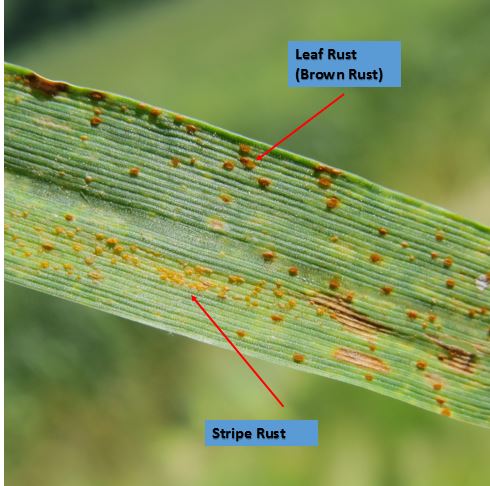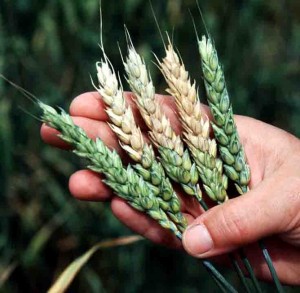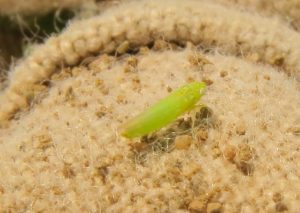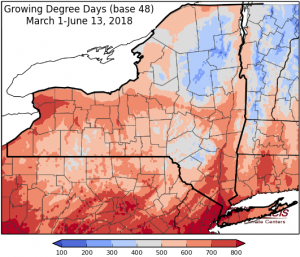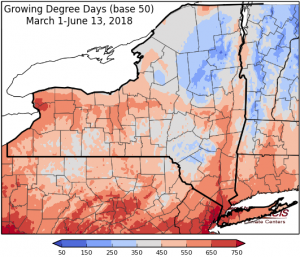Contents
Cornell University Willsboro Research Farm Open House
Willsboro, NY – June 6, 2018
The Cornell University Willsboro Research Farm will hold an open house on Tuesday, July 10 from 1:30pm to 4:00pm. A tour of the facilities and research plots will leave the main office (48 Sayward Lane, Willsboro) at 2:00pm. Light refreshments will be provided.
Research topics featured at this year’s open house include corn silage variety trials, adaptive nitrogen management for field corn, cover crops, juneberry nursery and production trials, Aronia variety plantings, honeyberry variety trial, high tunnel vegetable production, reduced tillage demonstration plots, season extension for early spring vegetables, organic pepper variety trial, and goldenberry and groundcherry variety evaluations.
In 1982 E. Vreeland Baker, a Willsboro farmer and entrepreneur, donated his 352 acre farm to Cornell University for agricultural research and demonstration. The facility serves to connect Cornell faculty in Ithaca with the challenges and issues facing North Country farmers. Willsboro Research Farm is part of the Cornell University Agricultural Experiment Station.
This event is free and open to the public. For more information call 518-963-7492.
View from the Field
Alfalfa Weevil
Alfalfa weevil is causing issues in alfalfa regrowth (after 1st cutting) across much the state. Remember if a field is having 50% tip feeding on regrowth and alfalfa is still short and larvae are small (1st or 2nd instar) you might consider an insecticide. If larvae are large they will pupate soon and not be a problem. Note, that if you spray alfalfa with an insecticide for alfalfa weevil you are killing the parasitoids that help control alfalfa weevil. Make sure that alfalfa weevil is really causing economic losses to alfalfa before choosing to spray.
IPM for Alfalfa Weevil in Alfalfa
Small Grain Diseases
Dr. Gary Bergstrom (Cornell University Extension Field Crops Plant Pathologist) is starting to see stripe rust and leaf rust on winter wheat in Monroe County and Seneca County. The following is a photo on how to tell them apart.
Gary is also reporting that fusarium head blight symptoms are starting to show up in malting barley. This disease makes malting barley unusable for malting. You can check for the risk for fusarium head blight in both spring and winter small grains at the Fusarium head blight prediction center http://www.wheatscab.psu.edu
Potato Leafhopper
Potato leafhopper is being found statewide at low population levels. With the current heat and possible dry conditions could be an indication potato leafhopper will increase over this time. The combination of heat and dry conditions seem to help potato leafhoppers increase quickly.
How to Scout for Potato Leafhopper
Weather Outlook – June 14, 2018
Jessica Spaccio
NOAA Northeast Regional Climate Center, Cornell University
Last week temperatures ranged from 6 degrees below normal to 2 degrees above normal. Precipitation has ranged from a trace to one inch. Base 50 growing degree-days ranged from 30-110.
Mostly dry through the weekend with increasing temperatures and humidity Sunday to Monday.
Today will be cooler and breezy with temperatures near 60s to the 70s. A few light scattered showers are likely for central to northern areas and gusty conditions are likely in eastern NY where gusts of 30-40mph are expected. Overnight lows will be in the upper 40s to mid 50s.
Friday will be sunny and dry with highs in the upper 60s to 70s. Overnight temperatures will be in the mid 40’s to Saturday will be a bit warmer with temperatures will be in the 70s to mid 80s. Overnight temperatures will be in the 50s to low 60s.
Sunday highs will be in the 80s with high humidity. Overnight temperatures will be in the 60s.
Monday highs will be in the 80s to mid 90s in some locations with showers and thunderstorms possible later in the day. High humidity conditions will continue, the heat index may reach upper 90s in areas of the mid-Hudson Valley. Overnight temperatures will be in the 60s.
Tuesday highs will be in the upper 70s to low 80s with a chance of showers with a frontal passage. Overnight temperatures will be in the upper 50s to mid 60s.
Wednesday highs will be in the upper 70s to low 80s. Overnight temperatures will be in the upper 50s to low 60s.
The seven-day precipitation amounts will range from a quarter of an inch to one inch.
The 8-14 day outlook (June 21-27) favors above-normal temperatures for all of the state. The precipitation outlook favors near-normal amounts for most of the state.
National Weather Service watch/warnings map
Degree Day Models for Field Crops across New York
New York Field Crop Pest Degree Day Accumulations for selected locations
(June 18, 2018)
| Station Location |
Alfalfa Weevil (Base 48) March 1 |
GDDs (Base 50 F) March 1 |
Seed Corn Maggot (base 39) January 1 |
Black Cutworm (Base 50) April 24 |
| Ceres | 762 | 655 | 1369 | 642 |
| Chazy | 614 | 514 | 1151 | 514 |
| Geneva | 819 | 712 | 1433 | 712 |
| Highland | 915 | 803 | 1624 | 791 |
| Ithaca | 793 | 686 | 1425 | 685 |
| Massena | 662 | 559 | 1200 | 559 |
| Northport (Richters) | 863 | 740 | 1643 | 719 |
| Valatie | 795 | 689 | 1410 | 655 |
| Versailles | 822 | 719 | 1464 | 712 |
| Watertown | 629 | 531 | 1184 | 531 |
Alfalfa Weevil Degree Day Model
Growing degree Days for peak (50%) Occurrence of Alfalfa Weevil growth stage:
| Stage |
Degree Days (Base 48) |
| Egg | 280 |
| Instar 1 | 351 |
| Instar 2 | 395 |
| Instar3 | 470 |
| Instar 4 | 550 |
| Cocooning | 600 |
| Pupa | 725 |
| Adult Emergence | 815 |
(Note: for alfalfa weevil predictions use Base Temp of 48F)
Alfalfa Weevil Degree Day Map
Base 50 degree day map
Seed Corn Maggot Peak Flight and Fly Maggot Free Degree Days
| Base Temp = 390 F | Peak 1st Generation | Seed Corn Maggot Fly Free degree days | Peak 2nd Generation | Seed Corn Maggot fly Free degree days | Peak 3rd Generation | Seed Corn Maggot fly Free degree days |
| degree days | 360 | 810 | 1,080 | 1530 | 1800 | 2250 |
Source: Insect IPM for Organic Field Crops: Seed Corn Maggot by Katelin Holm and Eileen Cullen
Black Cutworm Degree Day Model
Degree Days Stage Feeding Activity
0 Moth Capture Egg Laying
90 Eggs Hatch
91-311 1st to 3rd Instar Leaf Feeding
312-364 4th Instar Cutting Begins
365-430 5th Instar Cutting Begins
431-640 6th Instar Cutting Slows
641-989 Pupa No feeding
Source: University of Minnesota Black Cutworm Trapping Network
Clipboard Checklist
Keith Waldron, NYS IPM
General
*Walk fields to check general field condition, weed issues, areas of soil erosion
*Watch for early season weeds: winter annuals, chickweed, henbit, field penny cress, shepherd’s purse, giant and common ragweed, purple deadnettle, lambsquarters, redroot pigweed, velvet leaf, Pennsylvania smartweed, common sunflower, quackgrass, foxtail
Alfalfa:
*Evaluate established legume stands for approximate days til harvest
*Monitor regrowth for alfalfa weevil, potato leafhopper
*Monitor new seedings for Pythium blight and Phytopthora Root Rot.
Small Grains:
*Monitor winter grain fields for growth stage, disease issues, cereal leaf beetle
*Check stands for diseases, cereal leaf beetle, weed escapes
*Monitor wheat for potential risk of fungal disease issues – consult Fusarium Head Blight
prediction model
Corn:
*Conduct plant population assessments, early season corn pests including seed corn maggot, white grub, wireworm, black cutworm, armyworm, slugs, diseases, weed issues, vertebrate damage
Soybeans:
*Post emergence weed evaluation, timely cultivation and/or weed management
*Conduct plant population assessments, early season corn pests including seed corn maggot, slugs, soybean aphid, diseases, weed issues, vertebrate damage
Pastures:
*Check and mend fences as needed.
*Check crop growth
*Invasive species, plants harmful to livestock
*Review/Plan rotation system
Equipment:
*Remove / clean soil and crop debris from equipment
*Arrange for custom weed control or check your own application or cultivator equipment for repairs.
*Carry appropriate / necessary NYS DEC and EPA required documents: (pesticide applicators license, pesticide labels, MSDS sheets, etc.) with application equipment
*Calibrate:
- planting equipment – maintain records on planting rate per field
- manure spreaders – maintain records on amount spread per field
- pesticide application equipment – Check nozzles, pumps, etc., recalibrate pesticide application equipment before use. Maintain pesticide use records
Storage:
* Check stored grain bins for temperature, moisture and signs of mold and insects. Aerate, core, transfer grain or treat as necessary
*Check forage allocation and anticipate feed program adjustments as forages from previous year are used up
*Plan where forages should be stored for optimum allocation next feeding season
*Mow around storage bins and facility to minimize pest hiding places
Dairy Cattle Barn Fly Management:
*Monitor animals and barn area for house fly, stable fly and other pest management needs including presence of rodents and birds.
*Check facilities for favorable fly breeding conditions: (organic matter + moisture): leaks in watering systems, roof gutters for leaks and potential overspill, drainage,
*Sanitation, sanitation, sanitation – clean animal resting areas, feed troughs, minimize source of moist organic matter i.e. fly breeding areas in barn and in adjacent animal loafing yard
* Continue fly monitoring: install “3X5″ index card fly speck monitoring cards throughout barn
*Use, replenish, replace fly management materials: sticky fly tapes/ribbons, insecticide baits, natural enemies (parasitoids), fly population monitoring (3 x 5) spot cards
*Consider purchase and release of Muscidifurax raptor and/or M. raptorellus natural enemies of house and stable fly pupae.
Dairy Cattle on Pasture:
*Monitor animals for presence of face flies, horn flies and stable flies. Action guidelines: face flies (average 10 per animal face), horn flies (average 50 / dairy per animal side, 200 / beef cattle per animal side), stable flies average 10 per animal (all four legs)
*Check feed bunk / water source locations for signs of stable fly breeding (moist undisturbed organic matter – spilled feed, round bales, etc.), minimize source of moist organic matter i.e. fly breeding areas in barn and in adjacent animal exercise yard.
*Check pasture for forage quality / quantity, rotate as appropriate
*Check pasture for vegetation poisonous to livestock
*Consider use of pasture fly traps to help reduce deer, horse and stable fly populations


